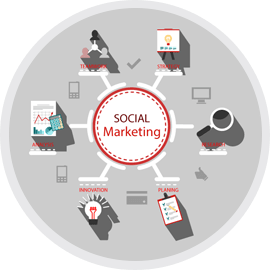SEO Strategy Core Components
There are a variety of ways you can optimize your website to rank higher in Google Search. It is important to have a strong SEO strategy that’s comprised of these three core components: technical setup, content, and links. Focusing on these three components while keeping the user at the center will boost your SEO efforts. Learn more about how WJ Media Group can help you through our SEO services in New Jersey.
1. Technical Setup
For your website to rank, three things must happen:
First, a search engine needs to find your pages on the web.
Then, it must scan them to understand their topics and identify their keywords.
And finally, it needs to add them to its index — a database of all the content it has found on the web. This way, its algorithm can consider displaying your website for relevant queries.
Seems simple, doesn’t it? Certainly, nothing to worry about. After all, since you can visit your site without any problem, so should Google, right?
Unfortunately, there is a catch. A web page looks different for you and the search engine. You see it as a collection of graphics, colors, text with its formatting, and links.
To a search engine, it’s nothing but text.
As a result, any elements it cannot render this way remain invisible to the search engine. And so, in spite of your website looking fine to you, Google might find its content inaccessible.
Website navigation and links
Search engines crawl sites just like you would. They follow links. Search engine crawlers land on a page and use links to find other content to analyze. But as you’ve seen above, they cannot see images. So, set the navigation and links as text-only.
Simple URL structure
Search engines don’t like reading lengthy strings of words with complex structures. So, if possible, keep your URLs short. Set them up to include as little beyond the main keyword for which you want to optimize the page, as possible.
Page speed
Search engines use the load time — the time it takes for a user to be able to read the page — as an indicator of quality. Many website elements can affect it. Image size, for example. Use Google’s Page Speed Insights Tool for suggestions on how to improve your pages.
Dead links or broken redirects
A dead link sends a visitor to a nonexistent page. A broken redirect points to a resource that might no longer be there. Both provide a poor user experience but also, prevent search engines from indexing your content.
Sitemap and Robots.txt files
A sitemap is a simple file that lists all URLs on your site. Search engines use it to identify what pages to crawl and index. A robots.txt file, on the other hand, tells search engines what content not to index (for example, specific policy pages you don’t want to appear in search.) Create both to speed up the crawling and indexing of your content.
Duplicate content
Pages containing identical or quite similar content confuse search engines. They often find it to be nearly impossible to display any of those pages at all. If search engines do find them, your website can be penalized. For that reason, search engines consider duplicate content as a negative factor.
2. Content
Every time you use a search engine, you’re looking for content — information on a particular issue or problem, for example.
True, this content might come in different formats. It could be text, like a blog post or a web page. But it could also be a video, product recommendation, and even a business listing.
It’s all content.
And for SEO, it’s what helps gain greater search visibility.
Here are two reasons why:
- First, content is what customers want when searching. Regardless of what they’re looking for, it’s the content that provides it. And the more of it you publish, the higher your chance for greater search visibility.
- Also, search engines use content to determine how to rank a page. It’s the idea of relevance between a page and a person’s search query that we talked about earlier.
While crawling a page, they determine its topic. Analyzing elements like page length or its structure helps them assess its quality. Based on this information, search algorithms can match a person’s query with pages they consider the most relevant to it.
The process of optimizing content begins with keyword research.
Keyword Research
SEO is not about getting any visitors to the site. You want to attract people who need what you sell and can become leads, and later, customers.
However, that’s possible only if it ranks for the keywords those people would use when searching. Otherwise, there’s no chance they’d ever find you. And that’s even if your website appeared at the top of the search results.
That’s why SEO work starts with discovering what phrases potential buyers enter into search engines.
The process typically involves identifying terms and topics relevant to your business. Then, converting them into initial keywords. And finally, conduct extensive research to uncover related terms your audience would use.
With a list of keywords at hand, the next step is to optimize your content. SEOs refer to this process as on-page optimization.
On-Page Optimization
On-page optimization, also called on-page SEO, ensures that search engines a.) understand a page’s topic and keywords, and b.) can match it to relevant searches.
Note, I said “page” not content. That’s because, although the bulk of on-page SEO work focuses on the words you use, it extends to optimizing some elements in the code.
You may have heard about some of them — meta-tags like title or description are the two most popular ones. But there are more. So, here’s a list of the most crucial on-page optimization actions to take.
Note: Since blog content prevails on most websites when speaking of those factors, I’ll focus on blog SEO — optimizing blog posts for relevant keywords. However, all this advice is equally valid for other page types too.
3. Links
From what you’ve read in this guide so far, you know that no page will rank without two factors — relevance and authority.
In their quest to provide users with the most accurate answers, Google and other search engines prioritize pages they consider the most relevant to their queries but also, popular.
The first two areas — technical setup and content — focused on increasing relevance (though I admit, some of their elements can also help highlight the authority.)
Links, however, are responsible for popularity.
But before we talk more about how they work, here’s what SEOs mean when talking about links.
What is a backlink?
Links, also called backlinks, are references to your content on other websites. Every time another website mentions and points its readers to your content, you gain a backlink to your site.
Link Building
In SEO, we refer to the process of acquiring new backlinks as link building. And as many practitioners admit, it can be a challenging activity.
Link building, if you want to do it well, requires creativity, strategic thinking, and patience. To generate quality links, you need to come up with a link-building strategy. And that’s no small feat.
Remember, your links must pass various quality criteria. Plus, it can’t be obvious to search engines that you’ve built them deliberately.
Here are some strategies to do it:
- Editorial, organic links: These backlinks come from websites that reference your content on their own.
- Outreach: In this strategy, you contact other websites for links. This can happen in many ways. You could create an amazing piece of content, and email them to tell them about it. In turn, if they find it valuable, they’ll reference it. You can also suggest where they could link to it.
- Guest posting: Guest posts are blog articles that you publish on third-party websites. In turn, those companies often allow including one or two links to your site in the content and author bio.
- Profile links: Finally, many websites offer an opportunity to create a link. Online profiles are a good example. Often, when setting up such a profile, you can also list your website there as well. Not all such links carry strong authority, but some might. And given the ease of creating them, they’re worth pursuing.
- Competitive analysis: Finally, many SEOs regularly analyze their competitors’ backlinks to identify those they could recreate for their sites too.
WJ Media Group: SEO Experts
Here at WJ Media Group, we provide the services companies need to successfully market their company using SEO. We have a broad education in marketing and work with multiple different companies currently. Further, contact us here or at (732) 670-6402.
SEO Strategy FAQs
What is an SEO strategy, and why is it important for online success?
An SEO strategy is a plan outlining the steps and techniques used to improve a website’s visibility on search engines. It involves keyword research, on-page optimization, content creation, link building, and technical improvements. A well-crafted SEO strategy is vital for online success as it helps your website rank higher in search engines, grow organic traffic, and drive more conversions and revenue.
What role does content play in an effective SEO strategy?
Content is a very important factor of a successful SEO strategy. High-quality, relevant, and engaging content helps attract and retain visitors, encourages backlinks, and signals authority to search engines. Regularly publishing fresh and valuable content, such as blog posts, articles, and guides, can significantly improve your website’s search engine rankings and overall visibility.
How does technical SEO contribute to an effective SEO strategy?
Technical SEO involves optimizing your website’s technical aspects to improve its crawlability, indexing, and overall performance. This includes optimizing page speed, ensuring mobile responsiveness, fixing broken links, implementing structured data, and creating XML sitemaps. By addressing technical issues, you provide search engines with a better understanding of your website, which can lead to improved rankings.
Related Articles
Cannabis Marketing & SEO in 2022
Post Views: 266 Organic Traffic is Your Best Friend Paid...
Read More5 Tips to Optimize Blog Posts Using SEO.
Post Views: 236 Using SEO and keywords in 2022 is...
Read More



